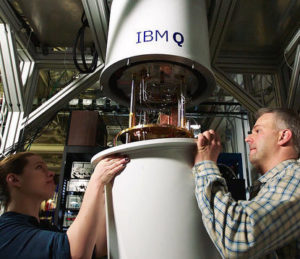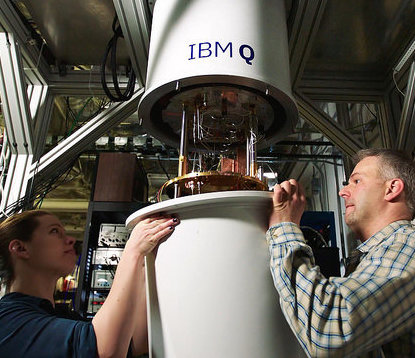 Today IBM announced today two significant quantum processor upgrades for its IBM Q early-access commercial systems:
Today IBM announced today two significant quantum processor upgrades for its IBM Q early-access commercial systems:
- The first IBM Q systems available online to clients will have a 20 qubit processor, featuring improvements in superconducting qubit design, connectivity and packaging. Coherence times (the amount of time available to perform quantum computations) lead the field with an average value of 90 microseconds, and allow high-fidelity quantum operations.
- IBM has also successfully built and measured an operational prototype 50 qubit processor with similar performance metrics. This new processor expands upon the 20 qubit architecture and will be made available in the next generation IBM Q systems.
These upgrades represent rapid advances in quantum hardware as IBM continues to drive progress across the entire quantum computing technology stack, with focus on systems, software, applications and enablement.
Clients will have online access to the computing power of the first IBM Q systems by the end of 2017, with a series of planned upgrades during 2018. IBM is focused on making available advanced, scalable universal quantum computing systems to clients to explore practical applications. The latest hardware advances are a result of three generations of development since IBM first launched a working quantum computer online for anyone to freely access in May 2016. Within 18 months, IBM has brought online a 5 and 16 qubit system for public access though the IBM Q experience and developed the world’s most advanced public quantum computing ecosystem.
Over the next year, IBM Q scientists will continue to work to improve its devices including the quality of qubits, circuit connectivity, and error rates of operations. For example, within six months, the IBM team was able to extend the coherence times for the 20 qubit processor to be twice that of the publically available 5 and 16 qubit systems on the IBM Q experience.
In addition to building working systems, IBM continues to grow its robust quantum computing ecosystem, including open-source software tools, applications for near-term systems, and educational and enablement materials for the quantum community. Through the IBM Q experience, over 60,000 users have run over 1.7M quantum experiments and generated over 35 third-party research publications. Users have registered from over 1500 universities, 300 high schools, and 300 private institutions worldwide, many of whom are accessing the IBM Q experience as part of their formal education. This form of open access and open research is critical for accelerated learning and implementation of quantum computing.
To augment this ecosystem of quantum researchers and application development, IBM rolled out earlier this year its QISKit project, an open-source software developer kit to program and run quantum computers. IBM Q scientists have now expanded QISKit to enable users to create quantum computing programs and execute them on one of IBM’s real quantum processors or quantum simulators available online. Recent additions to QISKit also include new functionality and visualization tools for studying the state of the quantum system, integration of QISKit with the IBM Data Science Experience, a compiler that maps desired experiments onto the available hardware, and worked examples of quantum applications.
Quantum computing promises to be able to solve certain problems – such as chemical simulations and types of optimization – that will forever be beyond the practical reach of classical machines. In a recent Nature paper, the IBM Q team pioneered a new way to look at chemistry problems using quantum hardware that could one day transform the way new drugs and materials are discovered. A Jupyter notebook that can be used to repeat the experiments that led to this quantum chemistry breakthrough is available in the QISKit tutorials. Similar tutorials are also provided that detail implementation of optimization problems such as MaxCut and Traveling Salesman on IBM’s quantum hardware.
This ground-breaking work demonstrates it is possible to solve interesting problems using near term devices and that it will be possible to find a quantum advantage over classical computers. IBM has made significant strides tackling problems on small scale universal quantum computing systems. Improvements to error mitigation and to the quality of qubits are our focus for making quantum computing systems useful for practical applications in the near future.
Sign up for our insideHPC Newsletter




